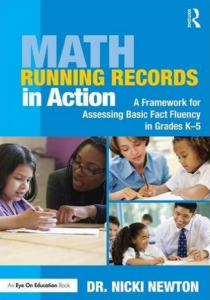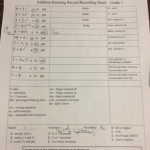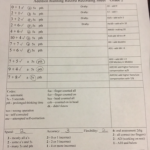
Chapter 4: Analyzing and Interpreting the Addition Running Record: How to Record and Describe What You See and Hear
- Compare your coding to mine for Coco’s thinking (from previous chapter page).
- Looking at the running record and Coco’s thinking, what would be your next instructional step with Coco?
- Then, listen to Dr. Nicki’s analysis of the running record video below
Look at a couple more running records I’ve created and comment on what you notice about the sample students’ thinking (videos are back on previous Chapter’s page). What would your instructional plan for each student?




When comparing my recording sheet to yours, I noticed I accurately scored the general codes, but need further practice with assessing the 5 levels of basic fact problem solving development. I scored 3+2 and 2+6 as a 2 because she said she counted on, where as you scored both of them a 4. I struggled with these two because although automatic, her explanation said she used counting so I marked her down. I think I am confused what to score, her answer or her thinking. On 7+7, although her answers was inaccurate, I gave her a 1 because she said she used counting. I didn’t realize wrong answers are 0. My final struggle was with 4+8. This time I gave her the 0 and you scored a 1. I’m not sure why I gave the 0 on this one. (Hard to recall) Anyway, it’s obvious I simply need some practice, especially with assessing thinking, the 0-4 codes.
Hi Kelly!
First of all, keep in mind that this is my observation of the interview. There are no rights and wrongs. It’s all about getting information that we can use to respond instructionally. Plus, I could have made a mistake as well since I chose not to put these codes on my version of the RR. I just felt that students used different ways of solving depending on the question and couldn’t be categorized into just one. It is based on research, though, so I will rethink this and discuss with my teachers this fall.
For the 3+2 and 2+6 expressions, I gave the 4 because she automatically said those. There didn’t appear to be any counting going on. On the front side, I don’t usually ask the children how they figured anything out. I’m basically just looking at their speed (although they don’t know it) and accuracy. So the only way I would circle a 0-3 on this front side is if it were completely obvious that was what they were doing. Dr Nicki has said that the students tend to say they did things that they really didn’t. They think that we want to hear fancy strategies for them all. She definitely counts on for some problems, so coding her here with a 1 certainly doesn’t hurt anything. So, I guess on this part 1 of the sheet, I just code what I see in terms of behavior and am more concerned about their speed and accuracy. Since her timing was under 3 seconds, I’d go for the automatic code.
This is where Dr Nicki and I have veered. She mentioned in the video that she gives wrong answers a 0 and it is described as “don’t know”. In my own practice in doing these, though, I reserve the “don’t know” for those students who tell me they have no idea what the answer is and don’t even try to give an answer. I think there are a lot of students who answer within 3 seconds and they are wrong. I’d rather see that in my coding by seeing “a” circled and then the x for wrong and the answer they gave. The answers can tell us a lot. A child who says 7+7 is 15 is very different than a child who says 77 which is different from a child who adorably looks at you and says they have no idea.
For the 4+8, please be aware that I checked the sheet she used in the video and compared it to the updated running record version. In the video, the problem was 3+8, not 4+8. So the student was correct in giving the answer of 11. That’s why I gave the 1.
Thanks so much for sharing how yours and mine differed. We all learn together!